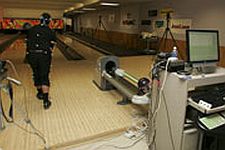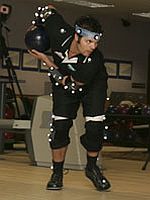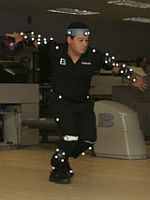Ridenour Motion Capture
USBC develops 'motion capture' system for bowling
Continuing to emphasize the important role that technology will have in growing the sport of bowling, the United States Bowling Congress has developed a system that measures and displays the exact movements of a bowler's body during the approach and delivery.
The USBC has patented this sophisticated biomechanics technology, which is called "motion capture." The futuristic-looking system is the first of its kind in the sport of bowling and is expected to be available in the new USBC training facility where it will be used to identify and correct problems with bowlers' techniques in a more comprehensive manner.
USBC has developed a "motion capture" system for bowling. The network of cameras, sensors and computers measure pressure points and exact movements of a bowler's body during the approach and delivery. The new biomechanics technology is expected to be available at the USBC training facility in Arlington, Texas, to analyze bowlers' technique. The idea is that eventually, bowling coaches -- like coaches in other sports who use this type of technology to improve performance -- can use motion capture in their lessons.
It is envisioned that eventually bowling coaches around the world will have access to motion capture and be able to use the system when giving lessons to their students.
Motion capture can measure body positioning and movement more precisely than standard video analysis programs. For example, motion capture can track a bowler's body positions (such as during the back swing) to 0.001 of an inch, speed and acceleration (such as ball speed or the sliding knee moving forward) to 0.02 mph and timing (relationship between the arm swing and footsteps) to 0.001 of a second.
The system works like this: Between 40 and 70 small sensors are attached to a bowler's clothing and six cameras positioned around the bowler on adjoining approaches and lanes pick up the red light reflected from the sensors. The bowler's movements through the approach and delivery are tracked via the sensors and the data is transmitted to a nearby connected computer system. The bowler's image appears on the computer screen as a moving, digital data figure that can be shown in slow motion, used with video or viewed from different angles.
"Our 'motion capture' system is the next step in the evolution of bowling technology and coaching," said USBC Research Engineer Paul Ridenour. "The precise data that motion capture provides for bowling coaches will make it easier to help bowlers improve their technique."
Motion capture is similar to the technology that video game-makers use to record Tiger Woods hitting a golf ball or NBA star and USBC spokesperson Chris Paul shooting a jump shot to make their game characters look realistic. Coaches in other sports use biomechanics technology to improve the performance of their athletes.
"In the near future, bowlers could visit the planned USBC national training center in Arlington, Texas, get hooked up to this equipment and have a coach analyze their game," Ridenour said. "Down the road, coaches worldwide may obtain this technology and bowlers may only need to visit their local USBC coach for a high tech lesson."
The world's top bowling coaches saw a sneak preview of the motion capture system at USBC Headquarters in suburban Milwaukee during a coach training event this past February. Among those in attendance was world-renowned Australian two-handed bowler Jason Belmonte, who tested the new system under the guidance of USBC engineers.
"Bowling, like all other sports, needs to keep moving forward with coaching techniques," said Belmonte, a USBC Silver coach and USBC Youth spokesperson. "This will be the future of coaching. The more accurate look a coach can get of a player's game, the better information that player will receive and the more likely the player will improve and enjoy tenpin bowling for a longer time."
Mexico's Daniel Falconi tests out the USBC motion capture system during an international coaching training seminar at USBC Headquarters in Greendale, Wis., this past February.
In addition to the motion capture system, USBC recently secured patents for two other biomechanics systems that it developed for use in coaching the sport. USBC research engineers created advanced technology that measures grip and foot pressure by transmitting body movement data to a computer via a series of pressure sensors connected to a bowler's throwing hand and feet.
Headline text
Article is courtesy of USBC.


